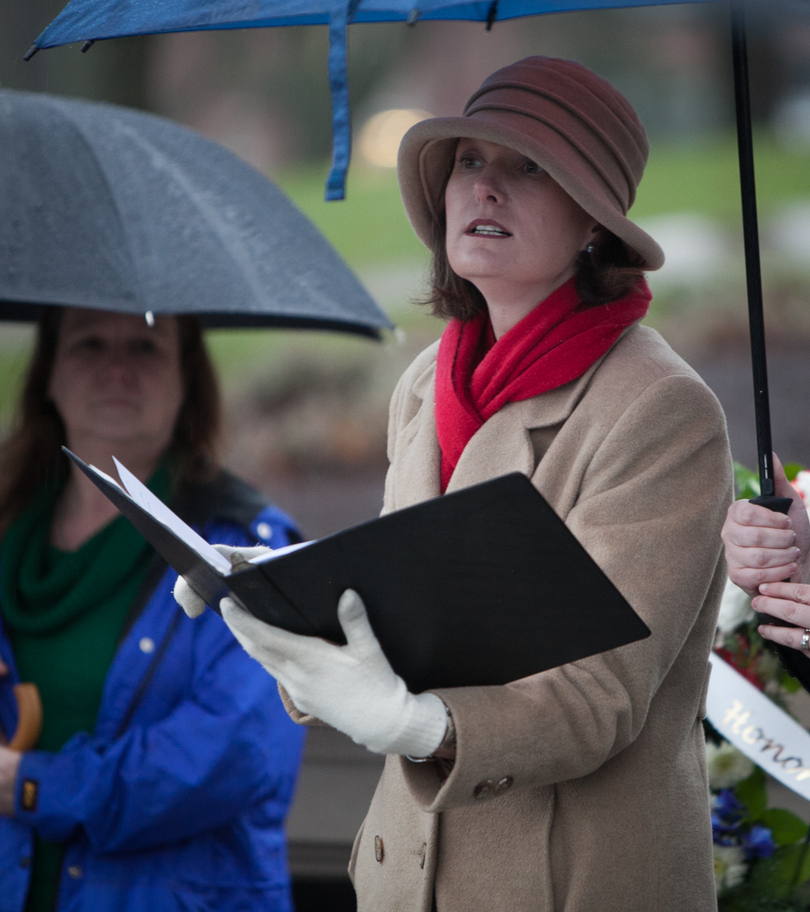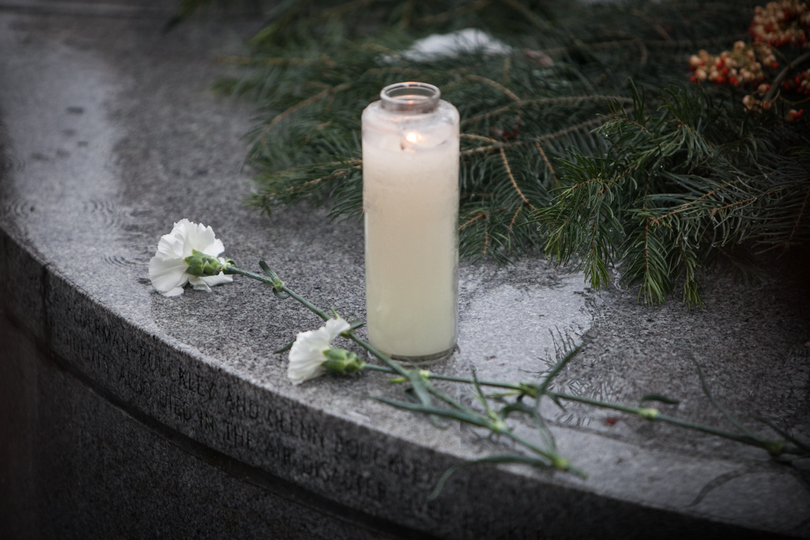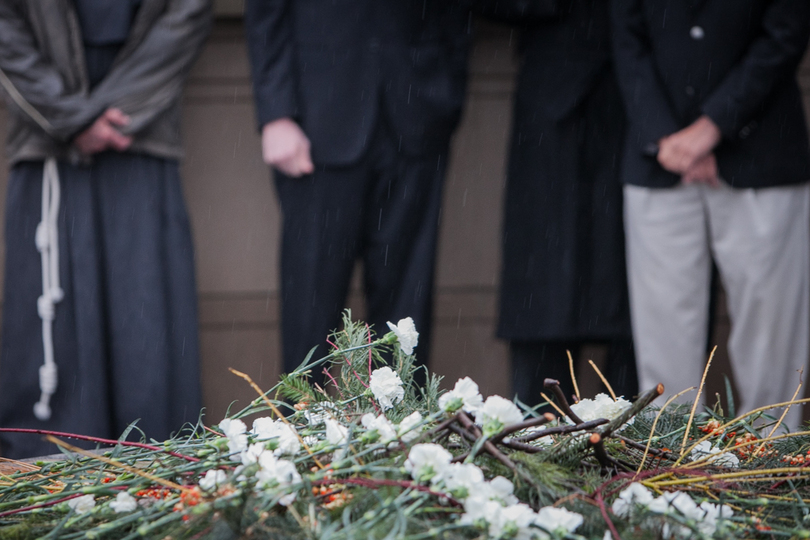After 25 years, Hendricks memorial service remembers Pan Am 103 victims
Addressing an audience of victims’ family and friends, members of the Syracuse University community and those who came to pay tribute, Tiffany Steinwert repeated a promise that “out of such evil can come good things.”
The evil that Steinwert, dean of Hendricks Chapel, spoke of was the bombing of Pan Am Flight 103 that took place over Lockerbie, Scotland on Dec. 21, 1988 – 25 years ago – and killed 270 people, 35 of them SU students.
As audience members filed into Hendricks Chapel for a memorial service Saturday afternoon, they were met with the somber sounds of an organ and a patchwork quilt displaying the names of the 35 SU students who lost their lives in the bombing. Once the sounds of the organ faded, Steinwert immediately commenced a moment of silence at 2:03 p.m. – the exact moment terrorists detonated the bomb aboard Pan Am Flight 103.
Following the moment of silence, Steinwert and the audience read a Common Prayer for Peace in unison, which she said attendees at other services across the world were also doing. She then reminded the audience of many of the “good things” that have come out of the tragedy.
“Although we would in an instant undo the past if we could, we are ever grateful for the deep bonds of friendship and solidarity that have arose between Syracuse and Lockerbie over the past 25 years,” she said.
The bond between Syracuse and Lockerbie, Steinwert said, has stood the test of time and remains a source of healing and hope for many of the friends, family and communities affected by the terrorist attack. To remember and honor those who lost their lives, she said people must gather together as a community, through prayer and solemn reflection, and look forward to a “future of hope.”
But for Judith Dios, it took time to attain a future that wasn’t underlined by sadness. Dios’ sister, Suzanne Marie Miazga, was one of the SU students who perished in the Pan Am Flight 103 attack.
She said for years she waited for the pain to go away and remembers wanting to feel normal again. Early on, “when the pain was so overwhelming,” she said her father told her he needed a “place to put the pain.” Since then, she said she and her family have found a place to put the pain.
“It’s almost as if it’s behind a door,” Dios said. “But if you crack that door, just a tiny bit, it comes back as fresh and as raw as the first day. So we keep the door closed a lot and we move on and on days like today, we open and honor it.”
And just like Steinwert promised, Dios said the tragedy brought forth some blessings for her family. Her mother, Anna Marie Miazga, is now in a romantic relationship with George White, who discovered Suzanne’s body in Lockerbie the day of the accident. “She was the first one he found,” Dios said.
Twenty-five years later, Dios said she is comforted by the fact that the university has kept its promise to remember the students lost in the attack – she referenced Melvin Eggers, who was dean in 1988, and his commitment to make sure the students would “never be forgotten.”
“It’s so fitting because my sister loved this school,” Dios said. “She was so honored to be here, and now they honor her.”
Suzanne’s name – along with the names of the other 34 SU students killed in the bombing – was read aloud at the service. The names echoed through the walls of Hendricks as Steinwert lit candles that represented each of the victims.
After reading a poem titled “We Remember Them,” which recognized the lasting legacy of the victims, Erin Carhart, a Remembrance Scholar, spoke about the power of memories and their ability to allow us to reflect on our past and act in our future. Remembrance Scholars are 35 SU seniors chosen each year to represent the lives lost and plan the university’s Remembrance Week. They are also awarded scholarships.
“You see, the memories that we have, those are the ones that have a profound effect on you,” said Carhart, a senior public affairs and women and gender studies major. “…These moments have shaped us. Do they define who we are? I’m not sure, but they are certainly a part of our past and a part of our future.”
She said the victims of Pan Am Flight 103 are remembered not as victims, but as the fathers, daughters, grandsons, friends and loved ones that brought joy and gave strength in the lives of those who knew them. Carhart added that remembering helps people act forward, enabling them to visualize opportunities that make it possible to create change.
When she was named a Remembrance Scholar, Carhart said she was unsure of what “acting forward” meant to her. But now, she said it has become one of her core values and a part of her legacy at SU. Carhart ended her speech by urging listeners to act forward in remembrance and hoping for peace.
Through receiving the scholarship, Interim Chancellor Eric Spina said Remembrance and Lockerbie Scholars learn a lot about themselves and the world, which is a testament to the tragedy’s lasting legacy on future generations of students.
Acts like these, along with all of the celebrations and ceremonies SU has each year, have kept the victims alive, he said. Though the events cement the fact that the victims lives were “tragically” taken, he said they also make people think of their own obligations to work toward achieving peace.
In the past 25 years, Spina said the depth of the sadness felt by the SU community and its perspective on the tragedy has changed. Even through the “deep grief,” he said there has been a positive outcome.
“It really makes two notions,” Spina said. “The terrible loss of 35 young lives, the promise they held, and some sort of reflection on that, but also some reflection on the light that has come to the world as a result of that loss and the formation of a community that cares more than ever before.”
The service proceeded to the Place of Remembrance where, under pouring rain, Steinwert described Dec. 21 as the “darkest night of the year,” comparing the fact that it was the winter solstice to it being the anniversary of the tragedy. After the winter solstice, the sun sets later in the day, which means each day has more sunlight – literally and metaphorically “turning the world back toward the light.”
“Therein lies our hope. Day by day, minute by minute, light seeps into our lives whether we realize it or not,” she said. “Over the past 25 years, that is indeed what has happened to us. Little by little, year by year, scholar after scholar, light has grown on this campus and around the world as people have been inspired, strengthened and moved by the legacy of the 270 souls who perished this fateful day.”
She referenced the Remembrance Scholars’ theme of acting forward and added that it is not enough to look back to the past, but that communities must act forward. Steinwert then beckoned the audience to place white roses in the center of the Remembrance Wall and say a prayer of hope, as well as a pledge of how they plan to act forward.
Steinwert described the bond the global community created in the aftermath of the attack as a “common chord,” which was created despite the evil intended by the attack. To close the service, she paid tribute to the 35 students, as well as the bond that has “knit the hearts of Syracuse and Lockerbie as one” – one of the “good things” that came out of the evil – with a Gaelic blessing.
Said Steinwert: “May the road rise up to meet you, may the wind be always at your back, may the sun shine warm upon your face, the rains fall softly upon your fields, until we meet again. And may your god hold you in the palm of god’s hand.”
Finally, she announced to the audience, “you may go in peace.”
Published on December 22, 2013 at 11:15 am
Contact Annie: apalme05@syr.edu








